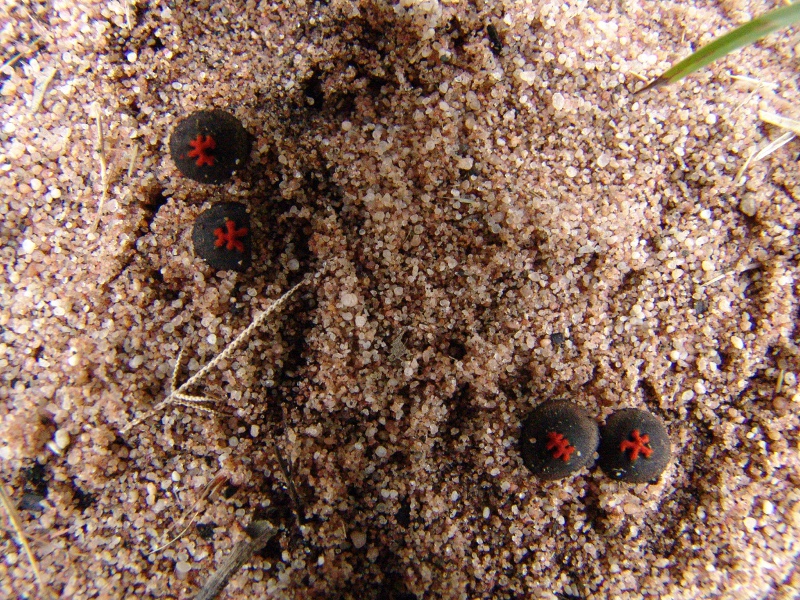Archive for Language and biology
April 23, 2016 @ 9:51 pm· Filed by Victor Mair under Language and biology, Language and culture, Language and literature
A few days ago, we looked at a propaganda poster in Beijing: "'Dangerous love'" (4/19/16).
In continuing research on this poster, I discovered that at one site where it was pasted on the wall, there was an enigmatic sequence of lines on another piece of paper pasted on the wall just to the right of the 16-panel poster that the whole world was talking about:

Sources: here and here (close-up).
Read the rest of this entry »
Permalink
March 13, 2016 @ 12:05 am· Filed by Victor Mair under Language and biology, Language and culture, Language and fashion
In my work on the Bronze Age mummies of Eastern Central Asia (ECA), one of the attributes that has struck me perhaps more powerfully than any other is their stupendous felt hats. Here's a photograph of some of them:

Read the rest of this entry »
Permalink
January 28, 2016 @ 7:48 am· Filed by Victor Mair under Etymology, Language and biology
Nick Kaldis writes:
I've started buying English etymology books for my 8-year-old daughter and I to explore; today we discovered that "butterfly" comes from "butter" + "shit", because their feces resemble butter.
Read the rest of this entry »
Permalink
January 2, 2016 @ 9:02 am· Filed by Victor Mair under Language and biology, Names, Writing systems
In a recent post, we discussed the creation of hitherto unknown Chinese characters:
"How to generate fake Chinese characters automatically" (12/30/15)
In that post and in other Language Log posts, we have mentioned how artists and language enthusiasts sometimes make completely new characters, whether out of whimsy or out of a genuine felt need (as though there were not already enough characters).
Read the rest of this entry »
Permalink
November 18, 2015 @ 8:09 pm· Filed by Victor Mair under Etymology, Language and biology
In "Shampoo salmon" (2/10/14), I called attention to the variety of opinions concerning the origins of the Chinese word bōluó 菠萝 / variant bōluó 波萝 ("pineapple"). Tom Nguyen suggests that another possible source is from Old Vietnamese *bla (> dứa /z̻ɨ̞̠ɜ˧ˀ˦/ with Northern accent – note the process of “turning into sibilant” of initial consonant cluster bl- in Vietnamese).
Read the rest of this entry »
Permalink
August 16, 2015 @ 8:48 am· Filed by Victor Mair under Animal behavior, Language and biology, Lost in translation
Over at Spicks & Specks, Greg Pringle has a virtuoso post on "The Bell Miner: How orthography and ornithology catalysed a new folk etymology" (8/9/15). It's about an Australian honeyeating bird — Manorina melanophrys — that used to be called the Bellbird, but was renamed Bell Miner through association with the South Asian bird called in Hindi the mainā मैना (" starling").
Read the rest of this entry »
Permalink
February 9, 2015 @ 12:01 pm· Filed by Victor Mair under Language and biology, Names
Chips Mackinolty sent in this intriguing photograph from Peter Cooke Darwin's tumblr, Life Is A Carnivore:

Read the rest of this entry »
Permalink
January 25, 2015 @ 1:32 pm· Filed by Victor Mair under Language and biology, Names
"Chinese character" is the name for a moth in this Wikipedia article. At first when I read the article, I thought that there must have been an error. But when I started to check around, I discovered that the same English name for Cilix glaucata occurred all over the place.
Read the rest of this entry »
Permalink
January 7, 2015 @ 8:34 am· Filed by Victor Mair under Language and biology, Language and food
Having immersed myself in Korean gizzard terminology for the past week, I now turn to Chinese gizzard terms, which are every bit as curious and varied, if not so intermittently scatalogical. Whereas the problems with Korean terms for gizzard centered primarily on their imprecision and vulgarity, the difficulties with Chinese terms for gizzard have more to do with pronunciation, topolectal variation, and the characters used for writing the various terms.
Read the rest of this entry »
Permalink
January 3, 2015 @ 6:01 pm· Filed by Victor Mair under Language and biology, Language and food, Lost in translation
Tim Leonard sent in this photograph of a sign for a Korean restaurant:

Read the rest of this entry »
Permalink
November 16, 2014 @ 6:56 pm· Filed by Victor Mair under Animal behavior, Animal communication, Language and biology
If you are a birder, you are in for a treat. If you are a bird watcher who is particularly fond of Chinese species, you are in for a double treat.
Craig Brelsford is a writer and editor living in Shanghai, China. Mr. Brelsford is currently creating the world's first photographic field guide to the birds of China. To that end, he travels constantly throughout the vast territory of China.
His peregrinations have taken him to 31 of the 34 provincial-level entities in China researching his field guide. As even the briefest of visits to his blog will attest, Mr. Brelsford is one serious birder.
Read the rest of this entry »
Permalink
October 16, 2014 @ 11:47 pm· Filed by Victor Mair under Language and biology, Translation
A new species of snail has been identified in eastern Taiwan. They're calling it Aegista diversifamilia as a way of remembering "the struggle for the recognition of same-sex marriage rights." The tie-in is that the snail is hermaphroditic. But this is really nothing new to snail-lovers, since the great majority of pulmonate snails, opisthobranchs, and slugs are hermaphrodites.
Read the rest of this entry »
Permalink
September 26, 2014 @ 2:50 pm· Filed by Mark Liberman under Language and biology, Nerdview
My new hobby, as Randall Munroe sometimes says, is asking biomedical researchers what "sensitivity" and "specificity" mean. The modal response is "Um, yes, I always have to look those up".
But recently, preparing a homework assignment about the evaluation of binary classifiers, I had a flash of insight. My new insight answers one of the questions I've always had about these terms: Why do biomedical researchers focus on the (apparently misleading) concepts that "sensitivity" and "specificity" denote? (My other question remains unanswered: Why did they pick those singularly un-mnemonic names? As far as I can see, they might as well have called them "delicacy" and "capacity", or "intensity" and "curiosity", or "Jupiter" and "Saturn".)
Read the rest of this entry »
Permalink



